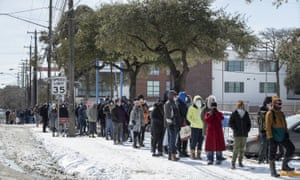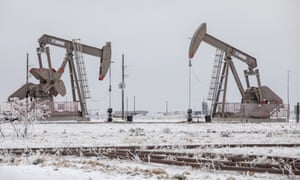When California saw widespread power blackouts last year during wildfires and a summer “heat storm”, Republican lawmakers from Texas were quick to deride the coastal state’s energy policies. “California is now unable to perform even basic functions of civilization, like having reliable electricity,” tweeted senator Ted Cruz during the record-breaking heatwave in August.
Those Republicans, including Cruz, had to swallow their words this week as a massive winter storm took out the Lone Star state’s power grid, leaving nearly 4 million people without electricity and heat amid polar temperatures.
The crises in California and Texas are different, in scale and severity. One faced fire, the other an ice storm. But experts say the power outages in both states make one thing clear: neither is prepared for the chaos of the climate crisis.
“There’s a lot of similarities, between what has happened in Texas and California,” said Roshi Nateghi, a researcher at Purdue University who studies infrastructure sustainability and resilience. “In both cases, you had an extreme climate or weather event. And in both cases, the states were not prepared.”
Over the past two decades, across the United States, severe weather has been the main cause of sustained power outages, Nateghi said.
An analysis of Department of Energy data published in September found weather-related power outages are up by 67% since 2000. Climate change is expected to continue fueling hotter heatwaves, more bitter winter storms and more ferocious hurricanes in the coming decades. As both California and Texas have discovered in recent years, power plants, generators and electrical lines are not designed to withstand the catastrophes to come. And all the while, the fossil fuels that both states rely on to power these faulty systems are driving the climate crisis, and hastening infrastructural collapse.
“We’re already seeing the effects of climate change,” said Sascha von Meier, a professor of electrical engineering at the University of California, Berkeley. “There will be more of this and it will get worse.”

California’s power system is facing pressure on two fronts: delivery and demand.
For the past few years, the state’s large electricity providers, Pacific Gas and Electric in the north and SoCal Edison in the south, have shut off power when its equipment is at risk of setting off wildfires amid dry conditions and high winds. Across the state, old, faulty power lines have sparked deadly wildfires – and the companies have said that updating their grids will take years.
The rolling blackouts during the heatwave in August came after state agencies failed to line up enough power to allow millions of residents blasting their fans and air conditioners all at once.
The heat storm was an “extraordinary event”, the state’s Energy Commission, Independent System Operator and Public Utilities Commission said in a report. “But it is our responsibility and intent to plan for such events, which are becoming increasingly common in a world rapidly being impacted by climate change,” they acknowledged.
Republicans across the US seized on the power outages to deride California’s climate and green energy policies, arguing that the state’s reliance on renewable energy sources like wind turbines and solar panels was to blame. But the issue wasn’t that California couldn’t produce enough power but that it didn’t invest in batteries to save and store power, von Meier said.
Texas, like California last summer, failed to plan for the extreme weather it is now facing. And as in California, its equipment was overdue for upgrades.
Last weekend, the state’s grid operators found their estimates of just how much energy residents would require this winter were off. At the same time, officials had allowed several power plants to go offline for maintenance. As temperatures dropped, households used more and more energy to keep warm – triggering rolling blackouts. By Monday, the icy conditions also disabled power plants, further diminishing the state’s power supply amid the deadly storm.

In a state that relies heavily on natural gas for power generation, infrastructure wasn’t equipped to withstand heavy snow and cold temperatures – wells froze, and the power outages made it impossible to pump the gas. “You need electricity to generate electricity, which really causes these disasters to escalate,” Nateghi said. And because most of the state operates its grid separately from the rest of the western region, largely to avoid federal regulations, Texas wasn’t able to easily import power from neighboring states.
In Texas and California, power issues have endangered elderly, poor and disabled residents most. When PG&E started pre-emptively shutting off electricity during the 2019 fire season, many disabled people found themselves in a precarious situation after their medical devices lost power and life-sustaining medications that required refrigeration began to go bad. Last year, when the heat storm triggered blackouts, the outage caused a failure at a wastewater treatment plant – forcing working-class people of color in Oakland to choose between opening windows to cool their homes, and closing them to shut out the smell as 50,000 gallons of raw sewage flowed in the nearby bay. Likewise, this week in Texas, the state’s poorest neighborhoods were the first and hardest hit by the prolonged outages.
Energy regulators enact blackouts “in supposedly the most efficient way – without necessarily a lens for equity”, Nateghi said. “Low income communities of color are always hardest hit, by power outages, by the pollution caused by power generation and by the extreme weather and climate change.”

To address all of these issues, scientists and advocacy groups are increasingly pushing for a decentralized power system that empowers communities to generate and store their own energy, using renewable sources – while investing in infrastructure that will allow regions to share power when disaster strikes.
Microgrids – small self-contained power systems that could draw from rooftop solar panels, nearby wind turbines and other sources, as well as larger regional grids – would allow communities to generate and ration their own electricity, von Meier said. “A neighborhood could essentially operate as a small power island,” she said. When the larger grid goes down due to natural disasters, a community could still keep basic infrastructure, hospitals and other necessities running with locally-sourced energy.
Von Meier herself loses power often due to shutoffs, and was without electricity at her home in Bay Area hills for nearly 24 hours last fall during fire season. “With a local grid, rather than having these very clumsy rotating power outages, where an entire neighborhood gets shut up completely, our neighborhood could have kept at least the basics running,” she said.
“What’s happened in California and Texas are warning signs,” said Nateghi. “These are signs we need to act now, and rethink our systems.”


Average Rating